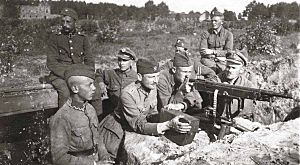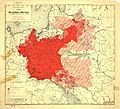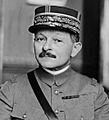Polish–Soviet War facts for kids
Quick facts for kids Polish–Soviet War, Interwar Period |
|||||||
|---|---|---|---|---|---|---|---|
| Part of The Russian Civil War | |||||||
 Polish defenses at Miłosna, during the decisive battle of Warsaw, August 1920. |
|||||||
|
|||||||
| Belligerents | |||||||
|
|
|||||||
| Commanders and leaders | |||||||
| Flag of Poland.svg | |||||||
| Strength | |||||||
| From ~50,000 in early 1919 to almost 800,000 in summer 1920 | From ~50,000 in early 1919 to ~738,000 in August 1920 | ||||||
| Casualties and losses | |||||||
|
estimated 60,000 killed |
About 48,000 killed 113,518 wounded 51,351 taken prisoner ------------------------ Names of Polish Armed Forces mortal casualties in period 1918 – 1920 totaling 47,055 |
||||||
The Polish–Soviet War was a big fight between Soviet Russia and Soviet Ukraine on one side, and the newly independent Second Polish Republic and the Ukrainian People's Republic on the other. It lasted from February 1919 to March 1921. The main goal was to control land in what is now Ukraine and parts of Belarus.
After the war, a peace treaty called the Peace of Riga was signed on March 18, 1921. This treaty divided the disputed land between Poland and Soviet Russia. Interestingly, much of the land given to Poland later became part of the Soviet Union after World War II.
Contents
Why the War Started
Poland's New Freedom
After World War I, Poland became an independent country again. For over 100 years, Poland had been divided up by other powerful countries. Now, leaders like Józef Piłsudski wanted to make Poland strong and secure. They hoped to create a large federation of countries in Eastern Europe. This would help protect Poland from both Germany and Russia.
Soviet Russia's Goals
At the same time, Russia was going through its own big changes. The Russian Revolution had happened, and the Bolsheviks (who were communists) had taken power. Their leader, Vladimir Lenin, wanted to spread communism across Europe. He saw Poland as a bridge to Germany and other Western European countries. If they could get through Poland, they believed they could help other communist revolutions.
Key Leaders and Early Fights
Polish Leaders
Józef Piłsudski was the main leader for Poland. He was a military hero and the head of the Polish state. He believed that Poland needed to be strong to survive. He led the Polish army in many important battles.
Soviet Leaders
On the Soviet side, key figures included Leon Trotsky, who was in charge of the Red Army. Generals like Mikhail Tukhachevsky and Alexander Ilyich Yegorov led the Soviet forces in different areas. Joseph Stalin also played a role in some parts of the war.
First Clashes
The first fights happened in early 1919. Polish forces moved east to secure their new borders. They clashed with the Red Army, which was also moving west. Both sides wanted control of the same territories, especially in Ukraine and Belarus.
Major Events of the War
Polish Advance into Ukraine
In April 1920, Poland launched a big attack called the Kiev Offensive. They teamed up with Symon Petlyura, a leader from the Ukrainian People's Republic. Their goal was to create an independent Ukraine that would be friendly to Poland. Polish forces captured the city of Kiev in May 1920.
Soviet Counterattack
The Soviet Red Army quickly fought back. They launched a huge counterattack in June 1920. General Tukhachevsky led the main Soviet push from the north. Another strong Soviet force, led by Semyon Budyonny (a famous cavalry commander), attacked from the south. The Polish forces were pushed back rapidly. It looked like the Soviets might win the war.
The Battle of Warsaw
The Soviet army advanced quickly towards Warsaw, the capital of Poland. This was a very dangerous time for Poland. Many people thought Warsaw would fall. However, the Polish army, led by Piłsudski and General Tadeusz Rozwadowski, planned a clever defense.
The battle took place in August 1920. It is often called the "Miracle on the Vistula" because Poland won against a much larger Soviet force. The Polish army launched a surprise attack from the side, hitting the Soviet forces when they least expected it. This caused the Soviet army to retreat in a hurry.
After Warsaw
After the Battle of Warsaw, the Polish army continued to push the Soviets back. Another important battle was the Battle of the Niemen River in September 1920. This battle further weakened the Red Army. Both sides were tired of fighting and ready for peace talks.
End of the War and Peace Treaty
Peace Talks Begin
Peace talks started in August 1920, even while fighting was still going on. The negotiations were difficult, but both sides wanted to end the conflict.
The Peace of Riga
The Peace of Riga treaty was signed on March 18, 1921. It officially ended the war. The treaty set the new border between Poland and Soviet Russia. Poland gained a large area of land to its east. However, it meant that the Ukrainian People's Republic, which had allied with Poland, was left out. This divided Ukraine between Poland and Soviet Russia.
Aftermath and Impact
Long-Term Effects
The Polish victory in the war stopped the spread of communism further into Europe. It also helped Poland secure its independence for the next two decades. The new border created by the Peace of Riga lasted until World War II. After World War II, the borders changed again, and much of the land Poland gained in 1921 became part of the Soviet Union.
The war was a very important event for both Poland and Russia. It shaped the future of Eastern Europe for many years.
Images for kids
-
Partitions of Poland–Lithuania in 1795: the coloured territories show the extent of the Polish–Lithuanian Commonwealth just before the First Partition. The land absorbed by the Kingdom of Prussia is in blue (north-west), by the Austrian Habsburg monarchy in green (south) and by the Russian Empire in red (east).
-
Map of areas where Polish was used as a primary language in 1916
-
Vladimir Lenin in 1919
-
Józef Piłsudski in 1919
-
General Józef Haller swearing for the Polish flag when he was nominated to command the Blue Army
-
Piłsudski in Vilnius
-
Piłsudski in Minsk
-
Polish soldiers enter Daugavpils, January 1920
-
Georgy Chicherin (left) with Maxim Litvinov in 1920
-
Józef Piłsudski (right in the train) and Symon Petliura, 16 May 1920
-
Mikhail Kalinin and Leon Trotsky greet the Red Army troops
-
Vladimir Lenin, Chairman of the Council of People's Commissars of Soviet Russia, delivers a speech to motivate troops to fight in the Polish–Soviet War on 5 May 1920
-
Polish troops in Kiev
-
Russian volunteers about to be sent to the Polish front
-
The image of Leon Trotsky on Polish propaganda poster from July 1920. The large caption reads "Bolshevik freedom". The small caption on the right-hand side reads: "The Bolsheviks promised: We'll give you peace. We'll give you freedom. We'll give you land, work and bread. Despicably they cheated: They started a war with Poland. Instead of freedom, they brought the fist. Instead of land, confiscation. Instead of work, misery. Instead of bread, famine". (Issued by) "Ministry of Military Affairs, Propaganda Department".
-
Władysław Sikorski and the 5th Army Staff in August 1920
-
Signing of the Peace of Riga
-
Poland after the Peace of Riga with the pre-partition borders of the Polish–Lithuanian Commonwealth also indicated
See also
 In Spanish: Guerra polaco-soviética para niños
In Spanish: Guerra polaco-soviética para niños












































